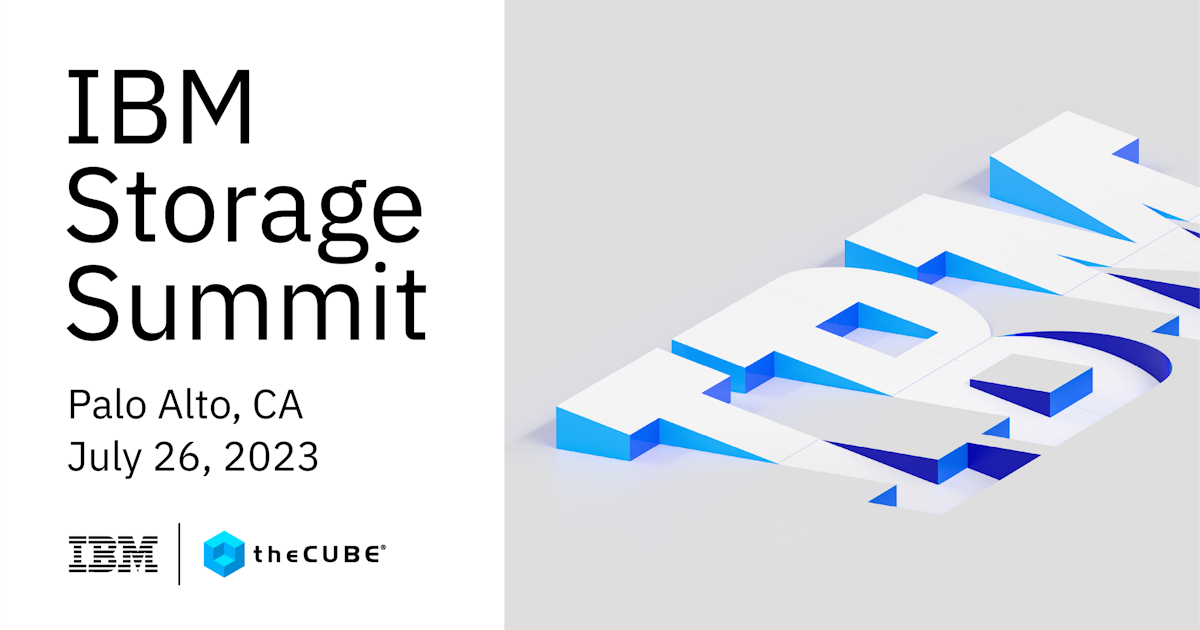 CLOUD
CLOUD
 CLOUD
CLOUD
 CLOUD
CLOUD
When IBM Corp. announced in a March blog post that it would make a number of product name changes to its portfolio of storage offerings, the move was more than just a rebranding exercise. The company was signaling its intent to align an extensive storage portfolio with the challenges of scale, performance and access that are part of the modern data-driven platform.
IBM aligned its hardware and software storage offerings across the areas of data and AI, hybrid cloud and data resilience. The company’s storage lineup now reflects the key pillars in the modern enterprise data stack, a necessary pivot in an age when data is the lifeblood for most businesses.
“Data is no longer just a bunch of bytes stuffed in a storage container, left to age,” said Dave Vellante, industry analyst for theCUBE and SiliconANGLE. “Rather data is fast becoming the digital representation of organizations’ business operations.”
On July 26, IBM will add another chapter to its storage evolution with an expected series of announcements during IBM Storage Summit. TheCUBE, SiliconANGLE Media’s livestreaming studio, will provide interviews with company executives, partners and industry analysts to dissect the latest news and how it could differentiate IBM from its competitors. (* Disclosure below.)
IBM provided an early hint of its interest in storage realignment with the announcement last fall that it would merge its data storage offerings with Red Hat’s OpenShift and Ceph, Red Hat’s open-source object and file storage system. IBM noted in its announcement that the move would provide customers with a unified storage experience for container-based apps running on OpenShift and offer a more consistent hybrid cloud experience through Ceph.
IBM’s storage realignment has also been focused on new capabilities for data and artificial intelligence. Its Storage Scale System, previously known as Elastic Storage, helps drive solutions for data management, including high-performance storage support for machine learning and AI.
IBM’s integration of what is now called Storage Fusion container-native software with Red Hat OpenShift environments will allow customers to discover, store and govern data across hyperconverged infrastructure. The re-designed storage portfolio reflects an interest on the part of IBM in helping customers with the challenges of hyper data growth and moving data across distributed systems.
“Data is the API by which organizations will program their business in the future,” Vellante said. “Moreover, AI is driving unprecedented new demands on storage platforms in terms of scale, performance and always-on global access.”
IBM has also taken steps in recent months to bolster storage protection for secondary and primary data. In early March, the company launched Storage Defender in partnership with data security platform provider Cohesity Inc.
Storage Defender creates data backups and recovery paths in the event of a breach or ransomware attack. Through a combination of IBM Storage Protect, Storage Fusion and Cohesity’s DataProtect solutions, users can copy, store and restore data on-premises or in the cloud through a centralized interface. A SaaS-based cybervault and automated recovery functions can provide data recovery in minutes or hours instead of days, according to IBM.
The realignment of IBM’s portfolio over the course of the past year reflects a transformation taking place within the storage industry. Rather than being viewed as a place where information is merely deposited for later use, storage has moved into a key role as a data enabler for the enterprise. IBM intends to capitalize on this trend, as seen by its announcements over the past year, and this will likely become more evident at the Storage Summit later this month.
“People are beginning to realize the importance that storage plays as the data custodian for the organization,” said Scott Baker, chief marketing officer and vice president of IBM infrastructure portfolio, who is scheduled to speak with theCUBE during the upcoming Summit and appeared in a previous interview in April. “Certainly, you have humans that are involved in setting strategies, but ultimately whatever those policies are that get applied have to be applied to a device that must act as a responsible custodian for the data it holds.”
Don’t miss theCUBE’s coverage of IBM Storage Summit on July 26. Plus, you can watch theCUBE’s event coverage on-demand after the live event.
We offer you various ways to watch theCUBE’s coverage of IBM Storage Summit, including theCUBE’s dedicated website and YouTube channel. You can also get all the coverage from this year’s events on SiliconANGLE.
SiliconANGLE also has podcasts available of archived interview sessions, available on iTunes, Stitcher and Spotify, which you can enjoy while on the go.
SiliconANGLE also has analyst deep dives in our Breaking Analysis podcast, available on iTunes, Stitcher and Spotify.
Stay tuned for the complete guest lineup on theCUBE, and check out theCUBE’s preview of our coverage at IBM Storage Summit:
(* Disclosure: TheCUBE is a paid media partner for the IBM Storage Summit. Neither IBM, the sponsor of theCUBE’s event coverage, nor other sponsors have editorial control over content on theCUBE or SiliconANGLE.)
Support our mission to keep content open and free by engaging with theCUBE community. Join theCUBE’s Alumni Trust Network, where technology leaders connect, share intelligence and create opportunities.
Founded by tech visionaries John Furrier and Dave Vellante, SiliconANGLE Media has built a dynamic ecosystem of industry-leading digital media brands that reach 15+ million elite tech professionals. Our new proprietary theCUBE AI Video Cloud is breaking ground in audience interaction, leveraging theCUBEai.com neural network to help technology companies make data-driven decisions and stay at the forefront of industry conversations.